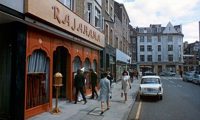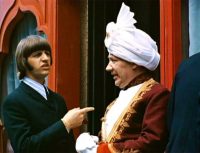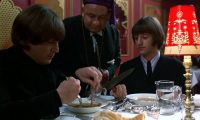The music and philosophy of India had a key effect on The Beatles’ music, particularly between 1965 and 1968. They tentatively began using traditional Indian instruments in 1965. Between 1966 and 1968 the group wrote three songs written by George Harrison in the Indian style.
George Harrison recorded three songs with The Beatles which were influenced by the Indian classical style. ‘Love You To’ was recorded for Revolver in 1966. The following year the second side of Sgt Pepper’s Lonely Hearts Club Band opened with ‘Within You Without You’.
Harrison’s Indian trilogy was completed by ‘The Inner Light’, the b-side of the ‘Lady Madonna’ single. Its lyrics were based on the Taoist holy book Tao Te Ching. The song’s backing track was recorded with Indian musicians in January 1968 in Bombay, where Harrison was producing the soundtrack to the film Wonderwall.
The Beatles’ exposure to Indian music occurred while they were making Help!, their second film.
We were waiting to shoot the scene in the restaurant when the guy gets thrown in the soup and there were a few Indian musicians playing in the background. I remember picking up the sitar and trying to hold it and thinking, ‘This is a funny sound.’ It was an incidental thing, but somewhere down the line I began to hear Ravi Shankar’s name. The third time I heard it, I thought, ‘This is an odd coincidence.’ And then I talked with David Crosby of The Byrds and he mentioned the name. I went and bought a Ravi record; I put it on and it hit a certain spot in me that I can’t explain, but it seemed very familiar to me. The only way I could describe it was: my intellect didn’t know what was going on and yet this other part of me identified with it. It just called on me … a few months elapsed and then I met this guy from the Asian Music Circle organisation who said, ‘Oh, Ravi Shankar’s gonna come to my house for dinner. Do you want to come too?’
Billboard, December 1992
On 5 and 6 April 1965 they shot the ‘Rajahama’ Indian restaurant scenes at Twickenham Film Studios.
The first time that we were aware of anything Indian was when we were making Help!. There was an odd thing about an Indian and that Eastern sect that had the ring and the sacrifice; and on the set in one place they had sitars and things – they were the Indian band playing in the background, and George was looking at them.We recorded that bit in London, in a restaurant. And then we were in the Bahamas filming a section and a little yogi runs over to us. We didn’t know what they were in those days, and this little Indian guy comes legging over and gives us a book each, signed to us, on yoga. We didn’t look at it, we just stuck it along with all the other things people would give us.
Then, about two years later, George had started getting into hatha yoga. He’d got involved in Indian music from looking at the instruments in the set. All from that crazy movie. Years later he met this yogi who gave us each that book; I’ve forgotten what his name was because they all have that ‘Baram Baram Badoolabam’, and all that jazz. All of the Indian involvement came out of the film Help!
George Harrison first played a sitar on the Rubber Soul song ‘Norwegian Wood (This Bird Has Flown)’, recorded in October 1965.
I went and bought a sitar from a little shop at the top of Oxford Street called Indiacraft – it stocked little carvings, and incense. It was a real crummy-quality one, actually, but I bought it and mucked about with it a bit. Anyway, we were at the point where we’d recorded the Norwegian Wood backing track and it needed something. We would usually start looking through the cupboard to see if we could come up with something, a new sound, and I picked the sitar up – it was just lying around; I hadn’t really figured out what to do with it. It was quite spontaneous: I found the notes that played the lick. It fitted and it worked.
Anthology
However, Norwegian Wood wasn’t the first Beatles release to feature a sitar. The North American version of the Help! album featured an instrumental, called Another Hard Day’s Night; a medley of ‘A Hard Day’s Night’, ‘Can’t Buy Me Love’ and ‘I Should Have Known Better’ performed on a sitar, tablas, flute and finger cymbals.
Although The Beatles didn’t perform on it, Another Hard Day’s Night soundtracked the film’s Rajahama restaurant scene. The music was written by Ken Thorne. The US Help! album was issued in August 1965, four months prior to Rubber Soul.




https://thebeatlesinindia.com/book/
What I would have given to be in India at the time……
I wish I was there too.
Yoko? Not really. They meditated days and weeks together in India. Then returned to England and went their 4 separate ways. Twas India that broke up the beast. They’ve all said the White Album was brutal. Ringo & George walked out. John shrugged and tried to get Clapton. We’ll never know what happened from the time they arrived in India and returned to England. But it sure wasn’t Bliss.
Amazingly, they produced a brilliant collection of pretty much solo songs. For that I’m grateful. As Paul said in Antholgy, Sod off, it’s The White Album.
What he actually said was ‘Shut up, it’s the bloody white album’.
I gotta say that, just as the 60’s years would not have been the same without the Fab Four, so the Beatles would not have been the same without George Harrison.
The influence of the Beatles on music and culture was great, including making the 60’s much more colorful.
The sounds of George on the Beatles albums and his sitar and melodies/lyrics just fit the ‘hip’ moods and the times and all of that philosophical talk, including counter-cultural ‘happenings.’
Really, I’m sayin’ the Beatles were moved more progressively because of George aside from the musical genius that they already had.
Can you relate..?
Such a wacky time.
They’re there with Maharishi (and Donovan and Mia and Prudence and Mike Love…) and Magic Alex. John is enthralled by Magic Alex. Maharishi, with his physics background, knows what a fraud Alex is. Big problem!
John is enraptured by Yoko, omnipresent in her letters and the clouds above, but is supposed to be having a “second honeymoon” at least in Cynthia’s hopes, with his wife. Big problem!
Ringo can’t take the food! A boyhood of unbelievably severe physical digestive-system assaults.
Paul… well Maharishi or not, he digs his Martin acoustic and writes a bunch of Martin acoustic-styled songs. He may not be enraptured, but he’s not impolite either.
George… He led them here. I guess he gets deflected from Maharishi when John (as prodded by Magic Alex) loses faith, but not for long. This is kind of a home in spirit.
And John, Paul, and George all write a ton of great songs, maybe just because they are kind of camping out together.
which bungalows did each stay?
no one seems to know or write it.
6 rooms, john, paul, george, ringo, mia/prudence and mike love? donovan?
standing in front facing the bungalow I think George was far left, he practiced sitar….but if he was in 1, who was in 2,3,4,5….and mia/prudence were in the far right bungalow.
this is life importance stuff, it has to be found out!!!!! lol